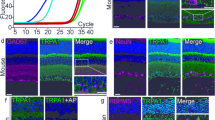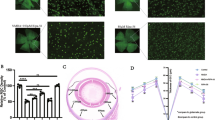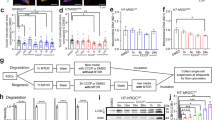Abstract
We investigated the neuroprotective effect of thioredoxin 1 (Trx1) and thioredoxin 2 (Trx2) which play critical roles in the regulation of oxidative stress on retinal ganglion cells (RGCs) in a rat glaucoma model. Expression of Trx1 and Trx2 and Trx-interacting protein (Txnip) was observed in the RGC layer (GCL), nerve fiber layer and inner nuclear layer. Txnip-, Trx1- and Trx2-expressing cells in the GCL were primarily colocalized with RGCs. The increased Txnip protein level was observed 2 and 5 weeks after glaucoma induction. Trx1 level decreased 2 weeks after glaucoma induction and more prominently after 5 weeks. No change in Trx2 levels was detected. The effects of Trx1 and Trx2 overexpression on RGC survival were evaluated 5 weeks after glaucoma induction. In nontransfected and EGFP-transfected (used as a negative control) retinas, RGC loss was approximately 27% compared with control. The loss of RGCs in Trx1- and Trx2- transfected retinas was approximately 15 and 17%, respectively. Thus, Trx1 and Trx2 preserved 45 and 37% of cells, respectively that were destined to die in glaucomatous retinas. The results of this study provide evidence for the involvement of oxidative stress in RGC degeneration in experimental glaucoma and point to potential strategies to reduce its impact.
This is a preview of subscription content, access via your institution
Access options
Subscribe to this journal
Receive 12 print issues and online access
$259.00 per year
only $21.58 per issue
Buy this article
- Purchase on Springer Link
- Instant access to full article PDF
Prices may be subject to local taxes which are calculated during checkout





Similar content being viewed by others
References
Quigley HA, Dunkelberger GR, Green WR . Chronic human glaucoma causing selectively greater loss of large optic nerve fibers. Ophthalmology 1988; 95: 357–363.
Sommer A, Katz J, Quigley HA, Miller NR, Robin AL, Richter RC et al. Clinically detectable nerve fiber atrophy precedes the onset of glaucomatous field loss. Arch Ophthalmol 1991; 109: 77–83.
Glovinsky Y, Quigley HA, Dunkelberger GR . Retinal ganglion cell loss is size dependent in experimental glaucoma. Invest Ophthalmol Vis Sci 1991; 31: 484–491.
Paquet-Durand F, Johnson L, Ekström P . Calpain activity in retinal degeneration. J Neurosci Res 2007; 85: 693–702.
Wang X, Ng YK, Tay SS . Factors contributing to neuronal degeneration in retinas of experimental glaucomatous rats. J Neurosci Res 2005; 5: 674–689.
Martin KR, Quigley HA, Zack DJ, Levkovitch-Verbin H, Kielczewski J, Valenta D et al. Gene therapy with brain-derived neurotrophic factor as a protection: retinal ganglion cells in a rat glaucoma model. Invest Ophthalmol Vis Sci 2003; 10: 4357–4365.
Ishii Y, Kwong JM, Caprioli J . Retinal ganglion cell protection with geranylgeranylacetone, a heat shock protein inducer, in a rat glaucoma model. Invest Ophthalmol Vis Sci 2003; 44: 1982–1992.
Tahzib NG, Ransom NL, Reitsamer HA, McKinnon SJ . Alpha-fodrin is cleaved by caspase-3 in a chronic ocular hypertensive (COH) rat model of glaucoma. Brain Res Bull 2004; 6: 491–495.
Haefliger IO, Dettmann E, Liu R, Meyer P, Prünte C, Messerli J et al. Potential role of nitric oxide and endothelin in the pathogenesis of glaucoma. Surv Ophthalmol 1999; 43: S51–S58.
Schori H, Kipnis J, Yoles E, WoldeMussie E, Ruiz G, Wheeler LA et al. Vaccination for protection of retinal ganglion cells against death from glutamate cytotoxicity and ocular hypertension: implications for glaucoma. Proc Natl Acad Sci USA 2001; 98: 3398–3403.
Di Matteo V, Esposito E . Biochemical and therapeutic effects of antioxidants in the treatment of Alzheimer's disease, Parkinson's disease, and amyotrophic lateral sclerosis. Curr Drug Targets CNS Neurol Disord 2003; 2: 95–107.
Savitt JM, Dawson VL, Dawson TM . Diagnosis and treatment of Parkinson disease: molecules to medicine. J Clin Invest 2006; 116: 1744–1754.
Browne SE, Beal MF . Oxidative damage in Huntington's disease pathogenesis. Antioxid Redox Signal 2006; 8: 2061–2073.
Barber SC, Mead RJ, Shaw PJ . Oxidative stress in ALS: a mechanism of neurodegeneration and a therapeutic target. Biochim Biophys Acta 2006; 1762: 1051–1067.
Chen X, Stern D, Yan SD . Mitochondrial dysfunction and Alzheimer's disease. Curr Alzheimer Res 2006; 3: 515–520.
Loh KP, Huang SH, De Silva R, Tan BK, Zhu YZ . Oxidative stress: apoptosis in neuronal injury. Curr Alzheimer Res 2006; 3: 327–337.
Emerit J, Edeas M, Bricaire F . Neurodegenerative diseases and oxidative stress. Biomed Pharmacother 2004; 58: 39–46.
Tezel G, Yang X, Cai J . Proteomic identification of oxidatively modified retinal proteins in a chronic pressure-induced rat model of glaucoma. Invest Ophthalmol Vis Sci 2005; 46: 3177–3187.
Tezel G . Oxidative stress in glaucomatous neurodegeneration: mechanisms and consequences. Prog Retin Eye Res 2006; 25: 490–513.
Kumar DM, Agarwal N . Oxidative stress in glaucoma: a burden of evidence. J Glaucoma 2007; 16: 334–343.
Fernandez-Checa JC, Garcia-Ruiz C, Colell A, Morales A, Mari M, Miranda M et al. Oxidative stress: role of mitochondria and protection by glutathione. Biofactors 1998; 8: 7–11.
Kirkland RA, Franklin JL . Prooxidant effects of NGF withdrawal and MEK inhibition in sympathetic neurons. Antioxid Redox Signal 2003; 5: 635–639.
Penn JS, Naash MI, Anderson RE . Effect of light history on retinal antioxidants and light damage susceptibility in the rat. Exp Eye Res 1987; 44: 779–788.
Gauntt CD, Ohira A, Honda O, Kigasawa K, Fujimoto T, Masutani H et al. Mitochondrial induction of adult T cell leukemia derived factor (ADF/hTx) after oxidative stresses in retinal pigment epithelial cells. Invest Ophthalmol Vis Sci 1994; 35: 2916–2923.
Nishinaka Y, Masutani H, Nakamura H, Yodoi J . Regulatory roles of thioredoxin in oxidative stress-induced cellular responses. Redox Rep 2001; 6: 289–295.
Nordberg J, Arnér ES . Reactive oxygen species, antioxidants, and the mammalian thioredoxin system. Free Radic Biol Med 2001; 31: 1287–1312.
Vlamis-Gardikas A, Holmgren A . Thioredoxin and glutaredoxin isoforms. Methods Enzymol 2002; 347: 286–296.
Nishiyama A, Matsui M, Iwata S, Hirota K, Masutani H, Nakamura H et al. Identification of thioredoxin-binding protein-2/vitamin D(3) up-regulated protein 1 as a negative regulator of thioredoxin function and expression. J Biol Chem 1999; 274: 21645–21650.
Junn E, Han SH, Im JY, Yang Y, Cho EW, Um HD et al. Vitamin D3 up-regulated protein 1 mediates oxidative stress via suppressing the thioredoxin function. J Immunol 2000; 164: 6287–6295.
Tanito M, Nishiyama A, Tanaka T, Masutani H, Nakamura H, Yodoi J et al. Change of redox status and modulation by thiol replenishment in retinal photooxidative damage. Invest Ophthalmol Vis Sci 2002a; 43: 2392–2400.
Tanito M, Masutani H, Nakamura H, Ohira A, Yodoi J . Cytoprotective effect of thioredoxin against retinal photic injury in mice. Invest Ophthalmol Vis Sci 2002b; 43: 1162–1167.
Inomata Y, Nakamura H, Tanito M, Teratani A, Kawaji T, Kondo N et al. Thioredoxin inhibits NMDA-induced neurotoxicity in the rat retina. J Neurochem 2006; 98: 372–385.
Zhou X, Li F, Ge J, Sarkisian Jr SR, Tomita H, Zaharia A et al. Retinal ganglion cell protection by 17-beta-estradiol in a mouse model of inherited glaucoma. Dev Neurobiol 2007; 67: 603–616.
Moreno MC, Campanelli J, Sande P, Sánez DA, Keller Sarmiento MI, Rosenstein RE . Retinal oxidative stress induced by high intraocular pressure. Free Radic Biol Med 2004; 37: 803–812.
Nishiyama A, Masutani H, Nakamura H, Nishinaka Y, Yodoi J . Redox regulation by thioredoxin and thioredoxin-binding proteins. IUBMB Life 2001; 52: 29–33.
Yokoyama A, Oshitari T, Negishi H, Dezawa M, Mizota A, Adachi-Usami E . Protection of retinal ganglion cells from ischemia-reperfusion injury by electrically applied Hsp27. Invest Ophthalmol Vis Sci 2001; 42: 3283–3286.
Dezawa M, Takano M, Negishi H, Mo X, Oshitari T, Sawada H . Gene transfer into retinal ganglion cells by in vivo electroporation: a new approach. Micron 2002; 33: 1–6.
Mo X, Yokoyama A, Oshitari T, Negishi H, Dezawa M, Mizota A et al. Rescue of axotomized retinal ganglion cells by BDNF gene electroporation in adult rats. Invest Ophthalmol Vis Sci 2002; 43: 2401–2405.
Ishikawa H, Takano M, Matsumoto N, Sawada H, Ide C, Mimura O et al. Effect of GDNF gene transfer into axotomized retinal ganglion cells using in vivo electroporation with a contact lens-type electrode. Gene Therapy 2005; 12: 289–298.
Tezel G, Wax MB . Glial modulation of retinal ganglion cell death in glaucoma. J Glaucoma 2003; 12: 63–68.
Masutani H, Ueda S, Yodoi J . The thioredoxin system in retroviral infection and apoptosis. Cell Death Differ 2005; 12: 991–998.
Saitoh M, Nishitoh H, Fujii M, Takeda K, Tobiume K, Sawada Y et al. Mammalian thioredoxin is a direct inhibitor of apoptosis signal-regulating kinase (ASK) 1. EMBO J 1998; 17: 2596–2606.
Fujino G, Noguchi T, Takeda K, Ichijo H . Thioredoxin and protein kinases in redox signaling. Semin Cancer Biol 2006; 16: 427–435.
Spyrou G, Enmark E, Miranda-Vizuete A, Gustafsson J . Cloning and expression of a novel mammalian thioredoxin. J Biol Chem 1997; 272: 2936–2941.
Tanaka T, Hosoi F, Yamaguchi-Iwai Y, Nakamura H, Masutani H, Ueda S et al. Thioredoxin-2 (TRX-2) is an essential gene regulating mitochondria-dependent apoptosis. EMBO J 2002; 21: 1695–1703.
Nonn L, Williams RR, Erickson RP, Powis G . The absence of mitochondrial thioredoxin 2 causes massive apoptosis, exencephaly, and early embryonic lethality in homozygous mice. Mol Cell Biol 2003; 23: 916–922.
Wang D, Masutani H, Oka S, Tanaka T, Yamaguchi-Iwai Y, Nakamura H et al. Control of mitochondrial outer membrane permeabilization and Bcl-xL levels by thioredoxin 2 in DT40 cells. J Biol Chem 2006; 281: 7384–7391.
Jia L, Cepurna WO, Johnson EC, Morrison JC . Effect of general anesthetics on IOP in rats with experimental aqueous outflow obstruction. Invest Ophthalmol Vis Sci 2000; 41: 3415–3419.
Munemasa Y, Ohtani-Kaneko R, Kitaoka Y, Kumai T, Kitaoka Y, Hayashi Y et al. Pro-apoptotic role of c-Jun in NMDA-induced neurotoxicity in the rat retina. J Neurosci Res 2006; 83: 907–918.
Piri N, Song M, Kwong JM, Caprioli J . Modulation of alpha and beta crystallin expression in rat retinas with ocular hypertension-induced ganglion cell degeneration. Brain Res 2007; 1141: 1–9.
Tanito M, Kwon YW, Kondo N . Cytoprotective effects of geranylgeranylacetone against retinal photooxidative damage. J Neurosci 2005; 25: 2396–2404.
Munemasa Y, Kim SH, Ahn JH, Kwong JM, Caprioli J, Piri N . Thioredoxins 1 and 2 are neuroprotective in retinal ganglion cells after optic nerve transection and oxidative stress. Invest Ophthalmol Vis Sci 2008; 49: 3535–3543.
Mansour-Robaey S, Clarke DB, Wang YC, Bray GM, Aguayo AJ . Effects of ocular injury and administration of brain-derived neurotrophic factor on survival and regrowth of axotomized retinal ganglion cells. Proc Natl Acad Sci USA 1994; 91: 1632–1636.
Kretz A, Schmeer C, Tausch S, Isenmann S . Simvastatin promotes heat shock protein 27 expression and Akt activation in the rat retina and protects axotomized retinal ganglion cells in vivo. Neurobiol Dis 2006; 21: 421–430.
Koeberle PD, Ball AK . Effects of GDNF on retinal ganglion cell survival following axotomy. Vision Res 1998; 38: 1505–1515.
Acknowledgements
We deeply thank Drs J Yodoi and H Masutani for providing Trx expression plasmids.
Author information
Authors and Affiliations
Corresponding author
Rights and permissions
About this article
Cite this article
Munemasa, Y., Ahn, J., Kwong, J. et al. Redox proteins thioredoxin 1 and thioredoxin 2 support retinal ganglion cell survival in experimental glaucoma. Gene Ther 16, 17–25 (2009). https://doi.org/10.1038/gt.2008.126
Received:
Revised:
Accepted:
Published:
Issue Date:
DOI: https://doi.org/10.1038/gt.2008.126
Keywords
This article is cited by
-
DNA and RNA oxidative damage in the retina is associated with ganglion cell mitochondria
Scientific Reports (2022)
-
Comprehensive measurements of hydroxylinoleate and hydroxyarachidonate isomers in blood samples from primary open-angle glaucoma patients and controls
Scientific Reports (2019)
-
Systemically administered peptain-1 inhibits retinal ganglion cell death in animal models: implications for neuroprotection in glaucoma
Cell Death Discovery (2019)
-
Association between systemic oxidative stress and visual field damage in open-angle glaucoma
Scientific Reports (2016)
-
Neuroinflammatory responses in diabetic retinopathy
Journal of Neuroinflammation (2015)



